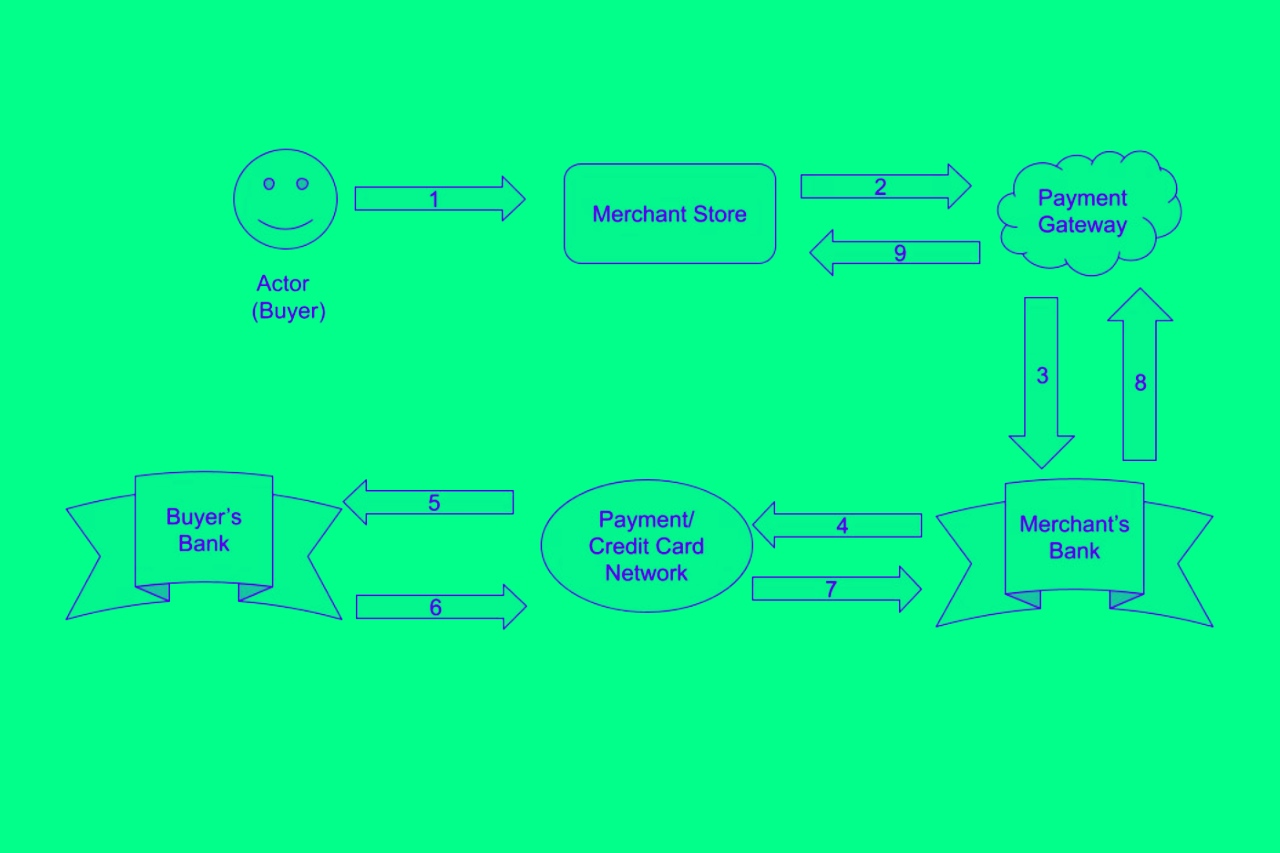What Is Marketplace Payment Processing?
Marketplace payment processing describes the functions, procedures, and technologies involved in online transactions, typically in a multi-vendor platform. This includes payment acceptance from buyers, sending payouts 2 to the sellers, and possibly building a way to store funds on the platform.
It seems simple enough, but it often involves multiple parties, especially for multi-vendor marketplaces. In addition to the buyer (card or account holder) and seller (merchant), other participants involved in traditional marketplace payment processing include the acquirer (merchant bank or service that processes payments), credit or debit card network or brand, and card issuing bank.
The participants involved may differ based on the type of transaction or payment being processed. For instance, cryptocurrency-based payments are still fairly new to being used in everyday marketplace transactions. As such, they aren’t likely to involve credit or debit card networks or issuer banks. However, they may be verified by transaction validators in the blockchain.
This highlights one significant challenge of modern marketplace payment processing. One of the biggest reasons customers abandon their carts at checkout is because the payment gateway doesn’t cater to their payment preferences.
If you want healthy conversion rates, your marketplace must provide potential customers with a diverse set of payment options.
Often, building this on your own can be quite complex. It requires you to build a scalable system that has multi-currency support and facilitates swift payment dispute resolutions.
Additionally, this system must be secure, provide ample user authentication, and perform optimally at all times. This means implementing performance monitoring tools and ensuring that you have adequate secure storage. But as you’ll see in the rest of the guide, this is just the tip of the iceberg.
The rest of the article explores the challenges and best practices associated with security and compliance and user experience (UX) and design when building a marketplace payment processing system.
Security and Compliance
If your global marketplace operates in multiple regions, it must comply with the specific personal data privacy regulations in each of those regions, such as the EU’s GDPR (General Data Protection Regulation) and Singapore’s PDPA (Personal Data Protection Act). Additionally, if your marketplace processes credit and debit card data, it is imperative to adhere to the Payment Card Industry Data Security Standard (PCI DSS). PCI DSS applies to any entity handling such payment data, ensuring its security.
While PCI DSS compliance should be a primary focus, it’s essential to recognize that some aspects of payment processing may fall outside its scope. For example, earlier versions of PCI DSS did not cover e-wallet transactions that didn’t involve primary account numbers (PANs). However, subsequent updates, like versions 3.2.1 and 4, have expanded the guidelines. This means that you should keep up-to-date with the latest standards in all regions where your business operates. The consequences of noncompliance, as evidenced by GDPR fines totaling over EUR 2.77 billion since 2018, can be financially debilitating, underscoring the importance of safeguarding both payment and personal data.
Employ Ample Encryption and Authentication
To ensure you’re providing adequate protection for data, you first need to cover the security basics. Most websites, including those with payment processing, use web encryption protocols such as Secure Sockets Layer (SSL) and Transport Layer Security (TLS) that ensure that data transmitted between your website (marketplace) and its users can’t be hijacked and spied on.
However, your online marketplace should employ this at large, not just for payment processing. Your payment gateway should also include end-to-end encryption (E2EE), which combines raw card data encryption, network tokenization, and payment data handler encryption. One of the best ways to implement E2EE is through JSON Web Encryption since it supports both symmetric and asymmetric encryption.
Employing strong customer authentication (SCA) is also a must. This entails requiring customers to have valid and verified user accounts before making a purchase. Moreover, your payment processing system must support multi-factor authentication (MFA), where two or more user verification methods are employed.
If you hope to legally operate in the European Economic Area (EEA), your system should implement 3D Secure to accept online credit card transactions. 3D Secure helps protect cardholders from fraudulent transactions by verifying credit/debit cards against three different domains when a transaction is initiated.
Meet Industry Security Standards
The goal is to secure customer data and payment information at all stages, which is essentially the initial step towards PCI DSS compliance. However, PCI DSS goes beyond securing transactions. To ensure compliance with PCI DSS standards, you can utilize their handy reference guide and the Report on Compliance Template.
The PCI DSS’s requirements can be condensed into six main points:
- Building and maintaining secure networks and systems
- Protecting card and account holder’s data
- Maintaining a vulnerability management program
- Implementing strong access control measures
- Regularly monitoring and testing networks
- Maintaining an information security policy
Adding comprehensive monitoring and fraud detection can be particularly tricky, considering that you have to do it while being fully data compliant. Moreover, these laws and regulations are frequently amended. As such, you’ll need to ensure that your fraud management and transaction tracking features are as frequently updated and conform accordingly.
Modern fraud management systems utilize machine learning and artificial intelligence to discern fraudulent transactions from genuine ones. They can potentially adjust to new rules and laws as they’re codified.
You also have to meet the specific data and payment security standards relevant to your industry. For example, if your marketplace deals with medical equipment, Protected Health Information, or health insurance provider payments, then adherence to the Health Insurance Portability and Accountability Act (HIPAA) is essential. If your marketplace offers credit or payment plans to consumers, compliance with the Financial Industry Regulatory Authority (FINRA) and the US Financial Crimes Enforcement Network’s (FinCEN) Know Your Customer (KYC) and Anti-Money Laundering (AML) regulations are necessary.
You should also pay particular attention to KYC and AML rules if your business operates in high-risk countries (on the gray and black lists) where financial crimes may be common. Of course, you don’t have to handle your marketplace’s security on your own.
Rapyd Protect is a first-of-its-kind cross-border fraud management solution designed to encompass all payment methods and provide full global coverage. It utilizes a specialized rule engine along with AI to detect high-risk transactions.
You can fully integrate it into your payment gateway system and never have to worry about complicated regional rules. However, Rapyd doesn’t take all control out of your hands. It also allows you to configure custom rules, manually assess high-risk transactions, block and filter bank identification number (BIN) ranges, etc.
User Experience (UX) and Design Considerations
Payment gateways tend to be the most underdeveloped parts of the online shopping experience. Many gateways offer white-label API solutions and leave it up to the client to build their interface while integrating with the API. Many out-of-the-box solutions tend to aim for function over form. As such, they typically don’t follow the same design and themes of the marketplace user interface. The contrast can often be shocking, making payment gates feel less trustworthy. Thus, the same care and consideration you place on your marketplace’s UX should also be applied to your payment processing system.
Scalability and Reliability
Many developers fail to consider how critical scalability is in payment processing. For years, Blockchain technology (particularly) has struggled with bottlenecking due to scalability issues.
Ultimately, too many complex transactions occurring subsequently can slow networks down and prolong transaction processing periods.
Likewise, if your system isn’t equipped to handle sudden spikes, it may experience constant dips in performance or worse—complete outages. Customers and users want an online payment processing experience that is smooth and seamless.
Long processing times may cause or increase online purchase anxiety. Even if your system is secure, slow transaction processing speeds indicate that something may be wrong. Thus, making it feel unsafe. This can cost you long-term customers.
To prevent this, you need to employ a performance monitoring tool to identify any bottlenecks or performance dips. Most good modern payment orchestration platforms and solutions allow you to monitor transactions in real-time.
Of course, you can implement or build your own transaction monitoring tool. It should provide you with full holistic visibility – showing you all key metrics. This will make it easier for you to identify why a transaction has failed or why it’s taken so long to process.
Nevertheless, transactions aren’t the only elements of your payment processing system as a whole whose scalability you should consider. Your payment processing and eCommerce may suffer downtime due to maintenance and updates. You can minimize complete service blackouts during these periods by ensuring that your web components are properly encapsulated and using an efficient continuous deployment strategy.
In some cases, downtime and outages may not be related to system updates. Unforeseen and unplanned outages can occur due to power failures, hardware issues, internet disruptions, etc. In these situations, the goal is to maintain service continuity or at least the illusion of it. First, your payment processing solution should have a status page that anyone can access and review to check if your system is down. You should also communicate with site visitors, informing them that your gateway or one of its providers is down.
You can also deal with payment provider outages using routing and cascading. However, this will require you to have a diversified set of payment providers. When one payment provider fails, you can send the buyer to another.
Diversify Your Payment Options
Modern payment processing systems still follow some of the core principles of the traditional payment process flow.




